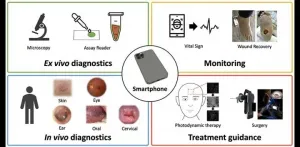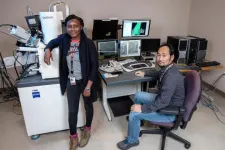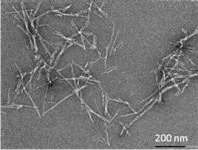(Press-News.org) DURHAM, N.C. - Researchers at Duke University have developed a method that uses machine learning, satellite imagery and weather data to autonomously find hotspots of heavy air pollution, city block by city block.
The technique could be a boon for finding and mitigating sources of hazardous aerosols, studying the effects of air pollution on human health, and making better informed, socially just public policy decisions.
"Before now, researchers trying to measure the distribution of air pollutants throughout a city would either try to use the limited number of existing monitors or drive sensors around a city in vehicles," said Mike Bergin, professor of civil and environmental engineering at Duke. "But setting up sensor networks is time-consuming and costly, and the only thing that driving a sensor around really tells you is that roads are big sources of pollutants. Being able to find local hotspots of air pollution using satellite images is hugely advantageous."
The specific air pollutants that Bergin and his colleagues are interested in are tiny airborne particles called PM2.5. These are particles that have a diameter of less than 2.5 micrometers -- about three percent of the diameter of a human hair -- and have been shown to have a dramatic effect on human health because of their ability to travel deep into the lungs.
The Global Burden of Disease study ranked PM2.5 fifth on its list of mortality risk factors in 2015. The study indicated that PM2.5 was responsible in one year for about 4.2 million deaths and 103.1 million years of life lost or lived with disability. A recent study from the Harvard University T.H. Chan School of Public Health also found that areas with higher PM2.5 levels are associated with higher death rates due to COVID-19.
But the Harvard researchers could only access PM2.5 data on a county-by-county level within the United States. While a valuable starting point, county-level pollution statistics can't drill down to a neighborhood next to a coal-fired power plant versus one next to a park that is 30 miles upwind. And most countries outside of the Western world don't have that level of air quality monitoring.
"Ground stations are expensive to build and maintain, so even large cities aren't likely to have more than a handful of them," said Bergin. "So while they might give a general idea of the amount of PM2.5 in the air, they don't come anywhere near giving a true distribution for the people living in different areas throughout that city."
In previous work with doctoral student Tongshu Zheng and colleague David Carlson, assistant professor of civil and environmental engineering at Duke, the researchers showed that satellite imagery, weather data and machine learning could provide PM2.5 measurements on a small scale.
Building off that work and focusing on Beijing, the team has now improved their methods and taught the algorithm to automatically find hotspots and cool spots of air pollution with a resolution of 300 meters -- about the length of a New York City block.
The advancement was made by using a technique called residual learning. The algorithm first estimates the levels of PM2.5 using weather data alone. It then measures the difference between these estimates and the actual levels of PM2.5 and teaches itself to use satellite images to make its predictions better.
"When predictions are made first with the weather, and then satellite data is added later to fine-tune them, it allows the algorithm to take full advantage of the information in satellite imagery," said Zheng.
The researchers then used an algorithm initially designed to adjust uneven illumination in an image to find areas of high and low levels of air pollution. Called local contrast normalization, the technique essentially looks for city-block-sized pixels that have higher or lower levels of PM2.5 than others in their vicinity.
"These hotspots are notoriously difficult to find in maps of PM levels because some days the air is just really bad across the entire city, and it is really difficult to tell if there are true differences between them or if there's just a problem with the image contrast," said Carlson. "It's a big advantage to be able to find a specific neighborhood that tends to stay higher or lower than everywhere else, because it can help us answer questions about health disparities and environmental fairness."
While the exact methods the algorithm teaches itself can't transfer from city to city, the algorithm could easily teach itself new methods in different locations. And while cities might evolve over time in both weather and pollution patterns, the algorithm shouldn't have any trouble evolving with them. Plus, the researchers point out, the number of air quality sensors is only going to increase in coming years, so they believe their approach will only get better with time.
"I think we'll be able to find built environments in these images that are related to the hot and cool spots, which can have a huge environmental justice component," said Bergin. "The next step is to see how these hotspots are related to socioeconomic status and hospital admittance rates from long-term exposures. I think this approach could take us really far and the potential applications are just amazing."
INFORMATION:
The results appeared online April 1 in the journal Remote Sensing.
This work was supported in part by the Duke Energy Initiative as well as the Office of the Provost at Duke University.
CITATION: "Local PM2.5 Hotspot Detector at 300 m Resolution: A Random Forest-Convolutional Neural Network Joint Model Jointly Trained on Satellite Images and Meteorology," Tongshu Zheng, Michael Bergin, Guoyin Wang and David Carlson. Remote Sensing, April 1, 2021. DOI: 10.3390/rs1307135
A team of scientists used a telescope on the International Space Station to measure the size of PSR J0740+6620 (J0740, for short), the most massive known neutron star. NASA's Neutron star Interior Composition Explorer (NICER) has captured unprecedented detail from this stellar remnant to learn more about matter in its core, which is on the threshold of collapsing into a black hole.
The NICER team will introduce their groundbreaking findings at a press conference during the 2021 APS April Meeting. NASA astronaut Christina Koch will join them to talk about how researchers use the space station as a science platform.
From pencils to pulsars
"Matter makes up everything we can see in the universe, from pencils ...
Researchers from Skoltech and a major European bank have developed a neural network that outperforms existing state-of-the art solutions in using transactional banking data for customer credit scoring. The research was published in the proceedings of the 2020 IEEE International Conference on Data Mining (ICDM).
Machine learning algorithms are already extensively used in risk management, helping banks assess clients and their finances. "A modern human, in particular a bank client, continually leaves traces in the digital world. For instance, the client may add information about transferring money to another person in a payment system. Therefore, every person obtains a large number of connections that can be represented as a directed graph. Such a graph gives an additional ...
A new study by Texas A&M University researchers published in END ...
Smartphones get smarter every day. These "Swiss Army knives" of mobile computing become even more useful with specialized attachments and applications to improve healthcare. Based on inherent capabilities like built-in cameras, touchscreens, and 3D sensing, as well wearable peripheral devices, custom interfaces for smartphones can yield portable, user-friendly biomedical imaging systems to guide and facilitate diagnosis and treatment in point-of-care settings.
What are the most effective ways to leverage and augment smartphone capabilities? Helpful guidelines are provided in a critical review of emerging smartphone-based imaging systems END ...
An imaging agent allows scientists to better visualize Enterobacterales infections in patients, helping to address pathogens that can be life-threatening and frequently resist antibiotics. The agent was safe in 26 patients and differentiated infections from either sterile inflammation or COVID-19-linked pneumonia in hamsters. Enterobacterales is the largest group of disease-causing bacteria in humans, and includes common pathogens such as Escherichia coli, Salmonella, and Klebsiella pneumoniae. These species have become increasingly resistant to common antibiotics, which has led the Centers for Disease Control to label some drug-resistant strains as urgent threats to human health. However, scientists still lack tools that can rapidly ...
New research from the Florida State University College of Medicine has found that the personality trait neuroticism is consistently associated with a higher risk of developing the brain disorder Parkinson's disease.
The research by Professor of Geriatrics Antonio Terracciano and team, published in Movement Disorders, found that adults in the study who scored in the top quartile of neuroticism had more than 80% greater risk of Parkinson's, compared to those who scored lower on neuroticism.
"Some clinicians think that the anxiety and depression is just the result of Parkinson's," Terracciano said. "However, our findings suggest that some emotional vulnerability is present early in life, ...
AMHERST, Mass. - Last month saw the average concentration of atmospheric carbon dioxide (CO2) climb to almost 418 parts-per-million, a level not seen on Earth for millions of years. In order to get a sense of what our future may hold, scientists have been looking to the deep past. Now, new research from the University of Massachusetts Amherst, which combines climate, ice sheet and vegetation model simulations with a suite of different climatic and geologic scenarios, opens the clearest window yet into the deep history of the Antarctic ice sheet and what our planetary future might hold.
The Antarctic ice sheet has attracted the particular interest of the scientific community because it is "a lynchpin in the earth's climate system, affecting everything from ...
Financial stress can have an immediate impact on well-being, but can it lead to physical pain nearly 30 years later? The answer is yes, according to new research from University of Georgia scientists.
The study, published in Stress & Health, reveals that family financial stress in midlife is associated with a depleted sense of control, which is related to increased physical pain in later years.
"Physical pain is considered an illness on its own with three major components: biological, psychological and social," said Kandauda A.S. Wickrama, first author and professor in the College of Family and Consumer Sciences. "In older adults, it co-occurs with other health problems like limited physical functioning, loneliness and cardiovascular ...
Florida State University researchers have discovered a novel way to improve the performance of electrical wires used as high-temperature superconductors (HTS), findings that have the potential to power a new generation of particle accelerators.
An image of Bi-2212, bismuth-based superconducting wires. (Mark Wallheiser/FAMU-FSU College of Engineering)
Researchers used high-resolution scanning electron microscopy to understand how processing methods influence grains in bismuth-based superconducting wires (known as Bi-2212). Those grains form the underlying ...
Amyloid fibrils are deposits of proteins in the body that join together to form microscopic fibres. Their formation has been linked to many serious human diseases including Alzheimer's, Parkinson's and Type 2 diabetes.
Until today, scientists have been unable to reliably measure the speed of fibril growth, as there have been no tools that could directly measure growth rate in solution. However, researchers from the UK's University of Bath and the ISIS Neutron and Muon Source have now invented a technique that does just that. Results from their study are published in RSC Chemical Biology.
"This is an important breakthrough, ...





